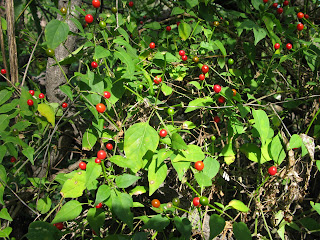I am in love with Wild Chiltepin -- the closest known relative to the first Mother Chile. Untold numbers of humans have been seduced by this tiny, but powerful fruit, for thousands of years. How do I know this? Human coprolites, or "pellets", tell us that humans have been ingesting wild chiles for more than 8000 years(Callen 1965; Nabhan 1997, Hodgson 2001)! And while some foods provide empty calories, this wild chile pepper is nourishing. It is a rich source of vitamins A,C,B2, niacin, and potassium.

When we put our fingers around one of these ancient chiles, we are holding a tiny, fragrant, time capsule, smaller than a pea. Picking just one chile connects us to all the other humans who, for thousands of years, have reached for wild chiles, in just the same way today. I am quite smitten with this connectedness to peoples in times past. My mind roams to all the women, men, and children who have picked this closest-chile-relative for eight thousand years! I marvel at the constancy of this wild chile as times of peace and conflict arose and fell, intonations of dialects morphed, languages died out or were born, different technologies, parenting styles, spiritual beliefs, and values arose and fell away. And still this little chile maintained itself. It resisted domestication. It insisted on wildness.
And with it's wildness comes a flavor that cannot be beat.
Tasting chiltepin right off the bush is a surprising experience. Unlike domesticated chiles - that burn with less heat, but a heat that lasts on the tongue - the chiltepin is more like the flame of a match. It's heat reveals itself quickly, but subsides more quickly too.This seems to hold true for the unripe, green chiltepin as well as the fresh or dried red fruits.
Harvesting chiletpin is a fragrant affair. As the fruit ripens from green to dark purple, then from orange to a dark red, it easily separates from the plant. There is a distinct aroma as the tiny fruit separates from the mother plant, and joins others in the harvesting sack. This is definitely an experience to be savored.! A fruity-chile aroma wafts into your olfactory-factory; and it is a smell you can taste on your tounge and feel on your skin.
Looking at the structure of this wild chile (below) reveals why it does not need humans to reproduce. In Gathering the Desert, Gary Nabhan writes, "The domesticated chiles are mostly pendant, rather than being erect on the stem in a position so that birds can reach them. Whereas chiletpines ripen quickly and stick out above the foliage like sore thumbs, domesticated Capsicums like peppers hang to the ground below the plants' foliage...". The quick ripening, and small size, mean that birds have a complete seed package to eat and distribute easily. Compare this strategy to that to larger chiles - which hang down, take longer to ripen, and are larger, therefore harder to carry if you are a bird, and you can see clearly why this chile has thrived for so many years.
If growing this plant is something that you would like to try in your own garden, keep in mind that chiltepin needs a nurse plant. It loves legumes, like mesquite, and large thorny bushes like Hackberry. Wildness appears to require relationship, and the chiltepin will thrive in a guild relationship where it can be shaded from the sun in the hot summers, and protected from frost in the winters. If you plant chiltepin with your domesticated chile annuals, in direct sun, it will likely die. If you nurture it under a nurse plant, it will thrive into the perennial it is - and can live for years, if not decades. I have watched and tracked chiletpin plants on our ranch in Mexico for over 15 years, and they were large and thriving well before we arrived!
Which brings us back to Wildness. To paraphrase Michael Pollan, wildness is more a quality than it is a place "out there". It cannot be bought nor manufactured - but it can be invited in. to invite some wildness into your life and garden with this wild plant can stir you in unexpected ways.
If you would like to learn to cook with this wild chile, email Cookingfreshtucson@gmail.com. My cooking partner Sally and I delight in using these ancient foods in our lives and kitchens daily. I'll post a photo of our Wild Chile University class, that was a fundraiser for Native Seeds SEARCH (a wonderful organization and a good place to by chiltepin to cook with, or seeds to sow. They are located in Tucson, AZ and on the web at: Nativeseeds.org). Recipes will be posted soon.
Think about experimenting with this tiny chile that packs such a punch - (yet is reported to be BENEFICIAL for the gastric world). It's versatility ranges from salsas, soups, beans and eggs, to adding it to salad dressings, spicy peanut sauces, cupcakes, coco ... I use it literally EVERY DAY!
One note: the oils on any chile can stay on your fingers for a time - and can be easily rubbed into eyes or other parts of the body that are painful. Take care to wash your hands well, or is a spoon or a grinder. (Native Seeds SEARCH sells little grinders made JUST for this type of chile pepper - Nativeseeds.org)
To buy this special chile for cooking or sowing:
*** Nativeseeds.org
To learn to cook with this fine, wild chile:
*** Cookingfreshtucson@gmail.com
To buy an already established chiltepin plant:
***Crosspollinating@gmail.com
Happy Gardening and Happy Cooking!



